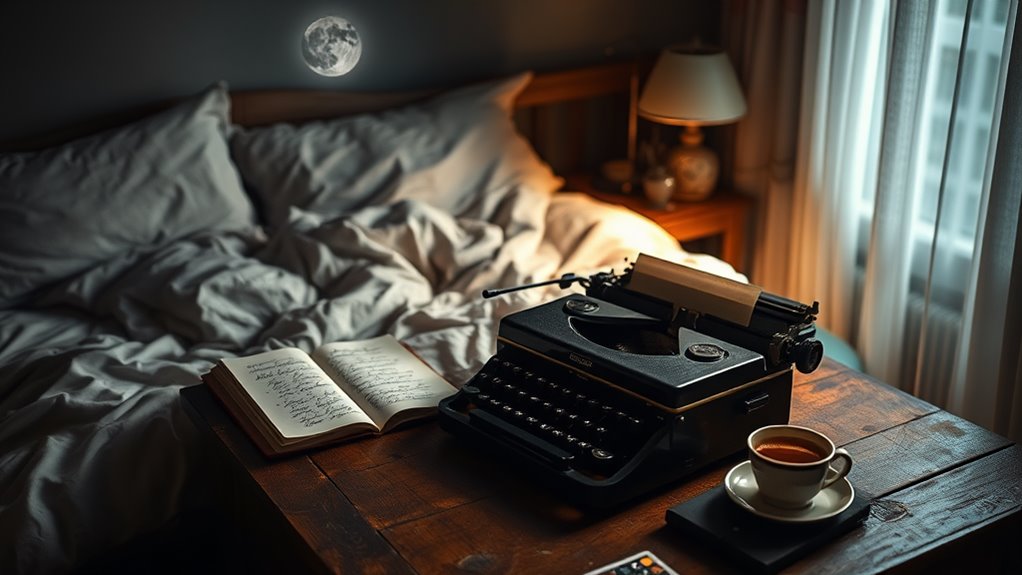I Write This Every Night to Fall Asleep Faster
Did you know that writing before bed can significantly improve your sleep quality? Many people underestimate the power of putting pen to paper at night. This simple act helps clear your mind of clutter and reduces anxiety, paving the way for a restful night’s sleep. If you’re curious about how to make night writing a part of your routine and enhance your relaxation, there are effective strategies to explore.
Key Takeaways
- Night writing helps clear your mind, reducing stress and making it easier to fall asleep faster.
- Engaging in free writing allows thoughts to flow, promoting relaxation and mental clarity.
- Establish a calming bedtime routine with dim lighting and minimal distractions to enhance your writing experience.
- Reflecting on your day and expressing gratitude can shift your mindset, fostering a sense of peace before sleep.
- Setting a specific time for night writing creates a consistent habit that signals your brain it’s time to unwind.
The Benefits of Night Writing for Sleep
Night writing offers a peaceful way to unwind before bed. By putting your thoughts on paper, you can clear your mind and release the day’s stresses. This calming practice helps you transition into sleep mode.
You’ll find that night writing encourages self-reflection, which can ease anxiety and promote relaxation. As you create, you focus on your emotions and experiences, allowing unresolved thoughts to surface.
This process not only enhances your mental clarity but also prepares your mind for restful sleep. Embrace night writing as a tool for better sleep, turning your nighttime routine into a calming ritual that fosters tranquility. Additionally, incorporating therapeutic benefits of night writing can significantly improve your overall sleep quality.
Creating a Calming Bedtime Routine
Creating a calming bedtime routine can significantly enhance your ability to fall asleep.
Start by setting a consistent sleep schedule; go to bed and wake up at the same time every day.
Create a peaceful environment by dimming the lights and reducing noise.
Engage in relaxing activities like reading a book or practicing gentle stretches.
Avoid screens at least an hour before bed to minimize blue light exposure.
Incorporate calming scents, like lavender, to soothe your senses.
Finally, take a few deep breaths to center yourself.
Writing a simple note before bed can also promote relaxation and ensure a more peaceful sleep.
With these steps, you’ll prepare your mind and body for a restful night’s sleep.
Writing Prompts to Clear Your Mind
How can writing prompts help clear your mind before bed? They allow you to express thoughts, emotions, and worries, creating mental space for relaxation. By focusing on prompts, you divert attention from stressors, promoting a calm mindset. Here are some prompts to try:
| Prompt | Purpose | Example |
|---|---|---|
| Reflect on your day | Process feelings | What was the best part? |
| List three things you’re grateful for | Cultivate positivity | What made you smile today? |
| Describe your ideal tomorrow | Set intentions | What would you do? |
| Write a letter to yourself | Encourage self-compassion | What advice would you give? |
| Create a bucket list | Inspire motivation | What do you want to achieve? |
Incorporating a mind dump ritual into your nightly routine can further enhance your mental clarity and relaxation.
Techniques for Effective Night Writing
What techniques can you use to enhance your night writing experience?
First, create a calming environment with soft lighting and comfortable seating.
Use a journal or digital device that feels good in your hands.
Limit distractions by turning off notifications and keeping your space clutter-free.
Set a specific time for writing to establish a routine.
Focus on free writing; let your thoughts flow without judgment.
Incorporate deep breathing to relax your mind before starting.
Lastly, consider using soothing music or nature sounds in the background to enhance your creativity.
These practices can transform your night writing into a peaceful ritual, as nightly journaling has been shown to promote relaxation and improve sleep quality.
How to Structure Your Night Writing Session
To make the most of your night writing session, a clear structure is key. Begin by setting a specific time and place to write. Create a calming atmosphere with soft lighting and minimal distractions.
Here’s a simple structure you can follow:
| Time | Activity | Notes |
|---|---|---|
| 8:00 – 8:10 | Prepare environment | Dim lights, quiet space |
| 8:10 – 8:30 | Free writing | Let thoughts flow |
| 8:30 – 8:50 | Review and edit | Refine your work |
| 8:50 – 9:00 | Reflection | Note feelings or insights |
| 9:00 | Wind down | Transition to sleep |
This method promotes clarity and relaxation. Additionally, incorporating a practice of night reflection can enhance your ability to clear the mind and reduce stress before sleep.
Overcoming Writer’s Block Before Bed
Ever wonder why writer’s block often strikes right before bed? Your mind’s fatigue can create a mental fog, making it tough to articulate thoughts.
To overcome this, try freewriting for a few minutes; let your ideas flow without judgment. Set a timer and focus solely on getting words down.
If that doesn’t help, switch gears—read a few pages of a book or jot down a list of topics you’re passionate about.
Integrating Night Writing Into Your Sleep Hygiene
Incorporating night writing into your sleep hygiene can transform your evening routine into a calming ritual.
Set aside 10-15 minutes before bed to jot down your thoughts, feelings, or daily reflections.
This practice helps clear your mind, easing anxiety and promoting relaxation.
Choose a comfortable space, free from distractions, and use a soft light to create a soothing atmosphere.
You might write in a journal or type on your device—whichever feels more comfortable.





